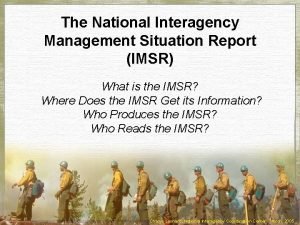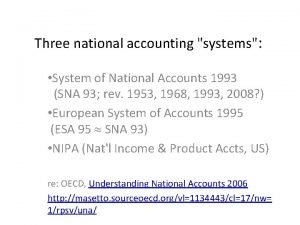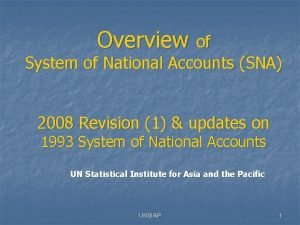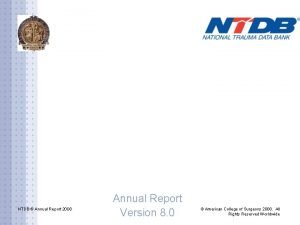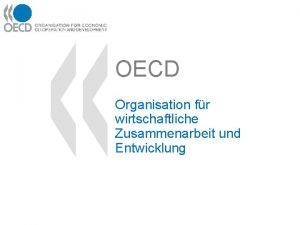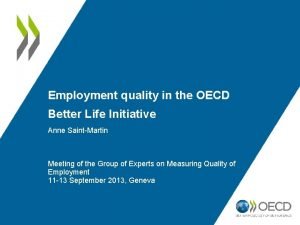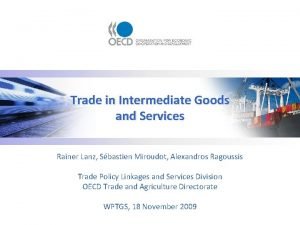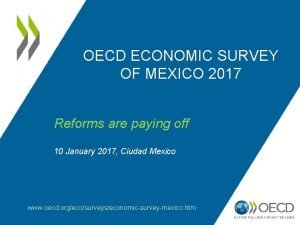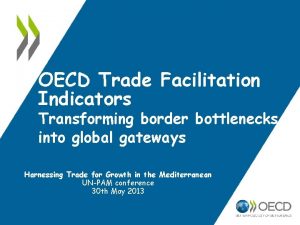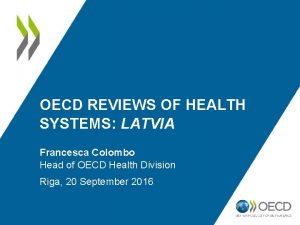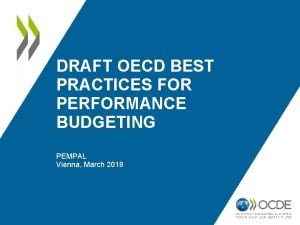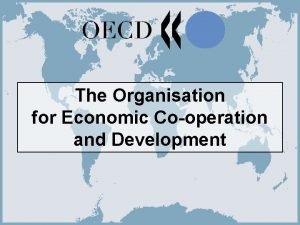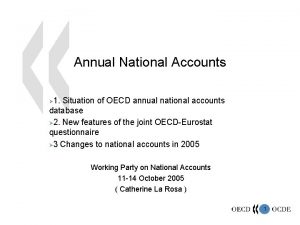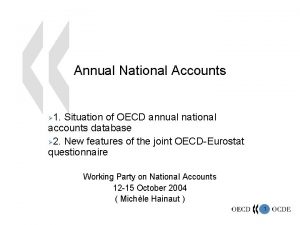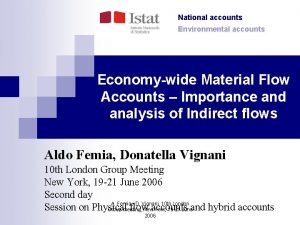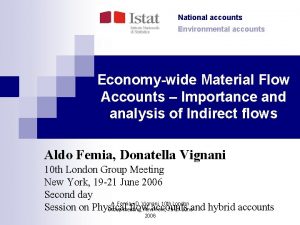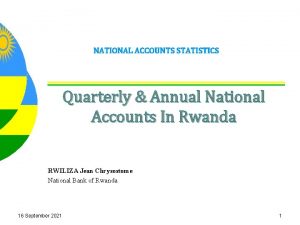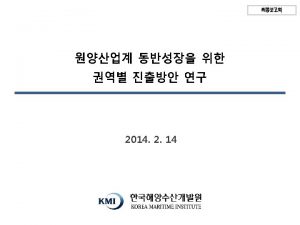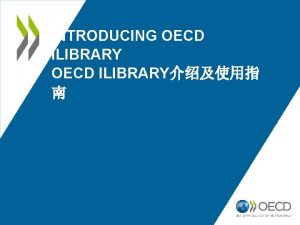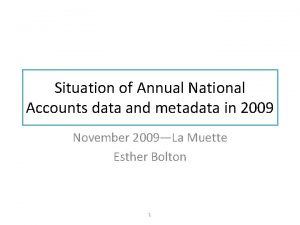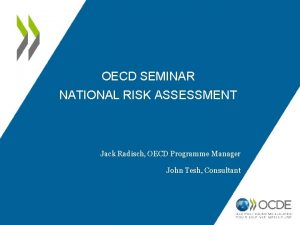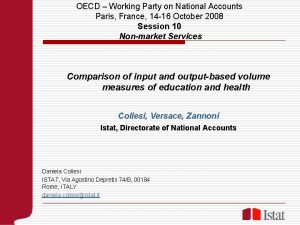Annual National Accounts 1 Situation of OECD annual















- Slides: 15

Annual National Accounts 1. Situation of OECD annual national accounts database Ø 2. New features of the joint OECD-Eurostat questionnaire Ø 3. COFOG 2 Project Ø 4. NAWWE Project Ø Working Party on National Accounts 10 -12 October 2006 ( Catherine La Rosa, Chantal Nicq, Nobuko Miyachiyo ) 1

1. Situation of OECD annual national accounts database n n Joint OECD-Eurostat questionnaire for the transmission of data Availability of data (see table pages 3 -4) – Improvements in completeness, timeliness and coverage for tables 0101 -0112. – Significant weakness: tables 1400 and 2000. n Dissemination of data (paper, CD-ROM and OLISnet) – Volume 1 Main aggregates - in January, free access on Internet for all users. – Volume 2 Detailed tables - in July – the electronic version covers, in addition, detailed non-financial accounts by sectors. Free access to officials via OLISnet, in OECD. STAT 2

1. Situation of OECD annual national accounts database (ctd) – Volume 4 General Government Accounts - in December –. Free access to officials via OLISnet, in OECD. STAT n Situation of the metadata transmission to the OECD – General government metadata – Employment metadata n Methodological changes – Different methodologies processed separately – Linkages of main aggregates – Example : Luxembourg GDP at current prices 3

1. Situation of OECD annual national accounts database (ctd) 4

2. New features of the joint OECDEurostat questionnaire n n Reorganisation – several of the tables 0101 -0112 are merged. Suppression and reduction – Tables 0113 -0116, 0118, 0122 -0127, 0119, 1400 are dropped – Table 0800: transactions and sector detail are reduced. n Extensions – – – Table 0301 -0303: A 60 breakdown (ISIC Rev. 3 division) Table 0302: GFCF in construction Table 0303: additional employment breakdown by sector Table 0501: full COICOP 3 -digits for households Table 1100: split between 1101 for GG and 1102 for sub sectors Table 2000 and 2200: new cross-classification A 17 (A 60) x AN_F 6 5

Recommendations n n n Ø Special effort should be made to supply tables on fixed assets. Data should be transmitted on the day the data are released by Member country sna. contact@oecd. org European Member countries are asked to send the questionnaire to both OECD and Eurostat at the same time. sna. contact@oecd. org 6

3. The COFOG 2 Project A reminder : extension of table 1100: n Strong demand in the European context for more disaggregated government expenditure data to improve the analysis of trends in the composition of government expenditure n Eurostat and the OECD agreed on extending table 1100 to the 2 nd level of COFOG only for the level of general Government (S. 13). n The OECD proposed to extend the project to non-EU countries 7

The COFOG 2 Project for non-EU countries n n A questionnaire was sent to 8 non-EU countries last December. None of them seems able to transmit COFOG 2 data in a near future. Only Australia and the United States publish data which resemble the COFOG 2 classification 8

The COFOG II Project for EU countries n n n Up to now 15 countries transmitted data to Eurostat on the second level of COFOG Many problems of classification still need to be solved. Creation of an electronic discussion group and preparation of a manual on sources and methods for COFOG statistics compilation 9

The COFOG 2 Project n n n In 2006 OECD had to postpone the issue of the new Table 1101. New meeting of the EU Task Force on COFOG scheduled next February. Hopefully preliminary data on COFOG 2 will soon be made public. The OECD is engaged in many studies on public expenditure efficiency which would really benefit from more disaggregated public expenditure data. 10

National Accounts World Wide Exchange Technical Overview – Nobuko Miyachiyo (OECD) October 2006 11

Rationale: Capitalise on Standards National Account standards exist already: SNA 93 defines a standard for national account statistical data. NSOs submit data files in a standard coding and format. Data Dissemination standards exist already: XML is the world standard for transmitting data between applications and organizations. SDMX-ML is the XML standard for defining, transmitting, validating, and interpreting statistical data and metadata between organisations. NAWWE capitalises on these standards to: Enhance national accounts data collection at the OECD. Provide other international organisations access to the same data collection standards. Facilitate data sharing and dissemination processes for NSOs. 12

Architecture: Data Flow OECD Web Server SDMX V 2. 0 XML Schemas <? xml version="1. 0" encoding="UTF-8"? > <xs: schema xmlns: xs="http: . . XML". . . > <xs: element name="Code"> <xs: complex. Type/> </xs: element>……. XML Files Structural XML <? xml version="1. 0"? > <Generic. Data> <Value>STRUCTURE</Value> </Data>STRUCTURE</Value> </Data> …… …… <Value>CANADA</Value> </Data> …… Navigation XML Files Validated By Schema Web Application Upload to ANA Database or Output to Other Format Data and Metadata Structure Definitions <Value>AUSTRALIA</Value> </Data> …… XML Files Copied to Server Cached Data XML <? xml version="1. 0"? > <Generic. Data> <Value>CANADA</Value> </Data> <? xml version="1. 0"? > …… <Genericdata> <Value>AUSTRALIA</Value> </Data> …… Content Process Checks for Updated XML Files <? xml version="1. 0"? > <Generic. Data> XML Files Transformed XML Potential to reduce the number of steps for validating and loading of NSO data into OECD systems 13

Prototype V 1: Web Interface Data selection criteria is driven from the Structural XML Data content is driven from the copied NSO XML data files Dimension criteria and countries can be combined for output 14

NAWWE 2006: Status XML Schemas and Structure Files: Data and Metadata structure definitions have been created based on SDMX-ML V 2. 0 XML schemas. Concepts included in the Metadata structure definition have been drawn from a draft version of the SDMX cross domain metadata concepts. Objectives of the Web Application: http: //stats. oecd. org/nawwe/ Generic loading of dimensions by interrogating data structure definition within structural XML. Ability to transform selected data or whole data files into alternative formats (GESMES, Excel, CSV). Tools to validate the quality of data and metadata (e. g. quantification of revision changes, missing information). NAWWE Technical Team: Nobuko Miyachiyo and Russell Penlington 15
 Nicc imsr
Nicc imsr York national accounts
York national accounts Advisory expert group on national accounts
Advisory expert group on national accounts National income and product accounts
National income and product accounts Systems of national accounts
Systems of national accounts System of national accounts (sna)
System of national accounts (sna) National trauma data bank annual report 2020
National trauma data bank annual report 2020 William hynes oecd
William hynes oecd Oecd
Oecd Oecd better life initiative
Oecd better life initiative Oecd trade
Oecd trade Oecd economic outlook
Oecd economic outlook Oecd trade facilitation indicators
Oecd trade facilitation indicators Francesca colombo drive in
Francesca colombo drive in Oecd good practices for performance budgeting
Oecd good practices for performance budgeting Oecd meaning
Oecd meaning
